Wildlife patients are commonly presented to first opinion veterinary practices throughout the country, with an estimated 131 000 wildlife patients presented to UK veterinary clinics each year (Barnes and Farnworth, 2017). It is likely that veterinary nurses will be required to nurse wildlife patients in clinical practice, and their nursing requirements can be vastly different from those of companion animals.
Initial contact
The initial contact usually comes in the form of a telephone call from a member of the public or a wildlife rescue, or from a member of the public bringing a wildlife patient directly to the veterinary clinic. This is an excellent time to gain as much information as possible. Unfortunately, wildlife patients do not come with much history unless they have been in captivity for some time, but this is an excellent opportunity to find out what species the patient is, where it was found or if the patient is injured or distressed. It is important to ascertain from the caller if they are in a safe place and if the patient is accessible. Accessibility may be difficult, and a member of the public should not be instructed to trespass on private land to access injured wildlife.
If the phone call is in relation to a juvenile animal it is important to determine whether that animal is injured or in distress, or whether it is performing normal behaviours. For example, fawns are often left by does under trees or in long grasses during the day, and every spring and summer fledgeling birds leave their nests for the first time. The recommendation is that if these young animals are not in distress or in danger from humans or other animals, then they should be left for 24 hours to observe if a parent animal is present and only brought for treatment if the parent animal does not return (Smith, 2016). Members of the public are often well meaning, however orphan juveniles in captivity often have a poor prognosis and may be difficult to release once they are grown because of imprinting, displayed in Figure 1, and lack of ecological niches.
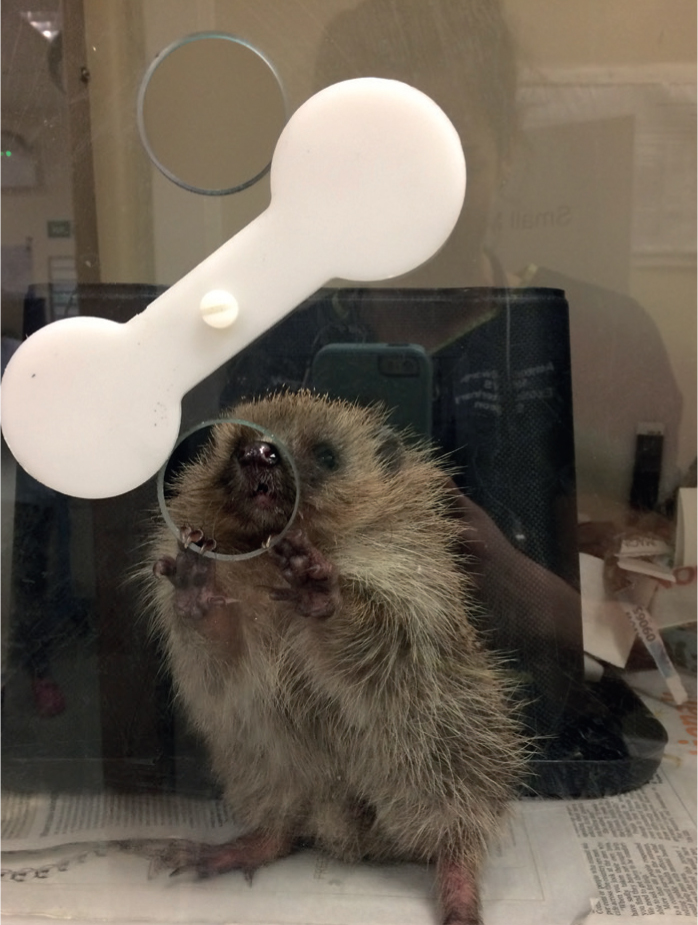
The Royal College of Veterinary Surgeons (RCVS) recently updated their professional code of conduct to give guidance on the treatment and possession of wildlife. Given that wildlife patients are by their very nature unowned, a member of the public is only deemed to be in possession of a wild animal until it is handed to a veterinary surgeon or veterinary practice for treatment, at which time ‘legitimate possession of the animal passes to the veterinary surgeon/practice’ (RCVS, 2020). While it is therefore not strictly necessary to then have the member of the public ‘sign over’ the wild animal, this may help to clear any doubt that the member of public is not in possession of the animal and has no legitimate claim to it following treatment or euthanasia. Some members of the public ask to be contacted with updates on the wildlife patient, and this communication can establish good rapport with potential clients, however it is up to the individual practice and staff members on whether they wish to provide this information once the patient has come into the care of the practice (RCVS, 2020).
Wildlife care can be an emotive issue for some members of the public, and there is a common misconception that all wildlife patients that present to veterinary clinics will be euthanased. While this is unfortunately a common occurrence, as any wildlife patient able to be captured and brought into a veterinary clinic will be incapacitated to some degree, communication and education of the public can help to dispel this myth. Some members of the public may refuse to present or hand over wildlife patients that are injured and in this circumstance careful discussion and education of the client on the legalities of obtaining and treating wildlife by members of the public should be undertaken.
Wildlife legislation
The Wildlife and Countryside Act (1981) makes it an offence to remove a wild animal, other than for the purpose of tending to it until it is fit for release. Schedule 4 of the Wildlife and Countryside Act lists species of birds of prey that must be ringed and registered if taken into captivity for care. However, this Act does not cover birds that have been bred in captivity, poultry or gamebirds. The Invasive Alien Species (Enforcement and Permitting) Order (2019) makes it illegal to keep or release several wild terrestrial species in captivity, including the grey squirrel (Sciurus carolinensis), muntjac deer (Muntiacus reevesi), ruddy duck (Oxyura jamaicensis) and Egyptian Goose (Alopochen aegyptiacus). While there is no requirement for veterinary practices to euthanase these animals specifically, they cannot be kept in captivity, and licences for their release can no longer be obtained through the government.
If any member of the veterinary team has any concerns over the welfare of a wildlife patient that is known to be in the possession of a member of the public following a discussion of the legalities of capture, treatment and release, then carefully considered contact with the relevant authorities should be sought (RCVS, 2020).
Patient triage
Immediately on entering the veterinary clinic, an initial triage should be performed, which includes an initial hands-off examination from a distance, followed by a brief physical examination while moving the animal from the carrier to a kennel to assess for any life-threatening injuries. Ideally, analgesia should be provided if required at this stage, under the direction of a veterinary surgeon, and the patient should be left to settle in a quiet, dark environment. It may be very quickly apparent that euthanasia may be required to end suffering, even with this brief examination. Table 1 indicates a series of questions that should be posed at the time of triage, which may have a significant impact on the prognosis for survival and release of wildlife patients and can have a significant effect on the decision to euthanase. The experience of the veterinary team and relationship with or distance from a wildlife rescue can also have an impact on the decision to treat. If the team does not feel that the needs and welfare of the patient can be adequately met during treatment, then this can also be used as justification for euthanasia.
Table 1. Important questions to be assessed at the time of presentation of the wildlife patient, and again following a full physical examination
|
Aims of treatment
The goal of treatment for wildlife patients is their release to the wild as quickly as possible with as little stress as possible (Meredith, 2016). Some wildlife patients can be released back into the wild with a disability, if they are kept in a semi-captive state, such as in a fenced garden or facility. However, this poses somewhat of an ethical dilemma, and places a number of the responsibilities on the person who is responsible for the land that the patient is released to and should be strongly discouraged. Some patients may require a more prolonged treatment course, if they are suffering from complicated infections or fractures (Figure 2). Some treatments requiring long-term follow up may require wildlife rescues to re-present the patent for follow up so that progress can be monitored.
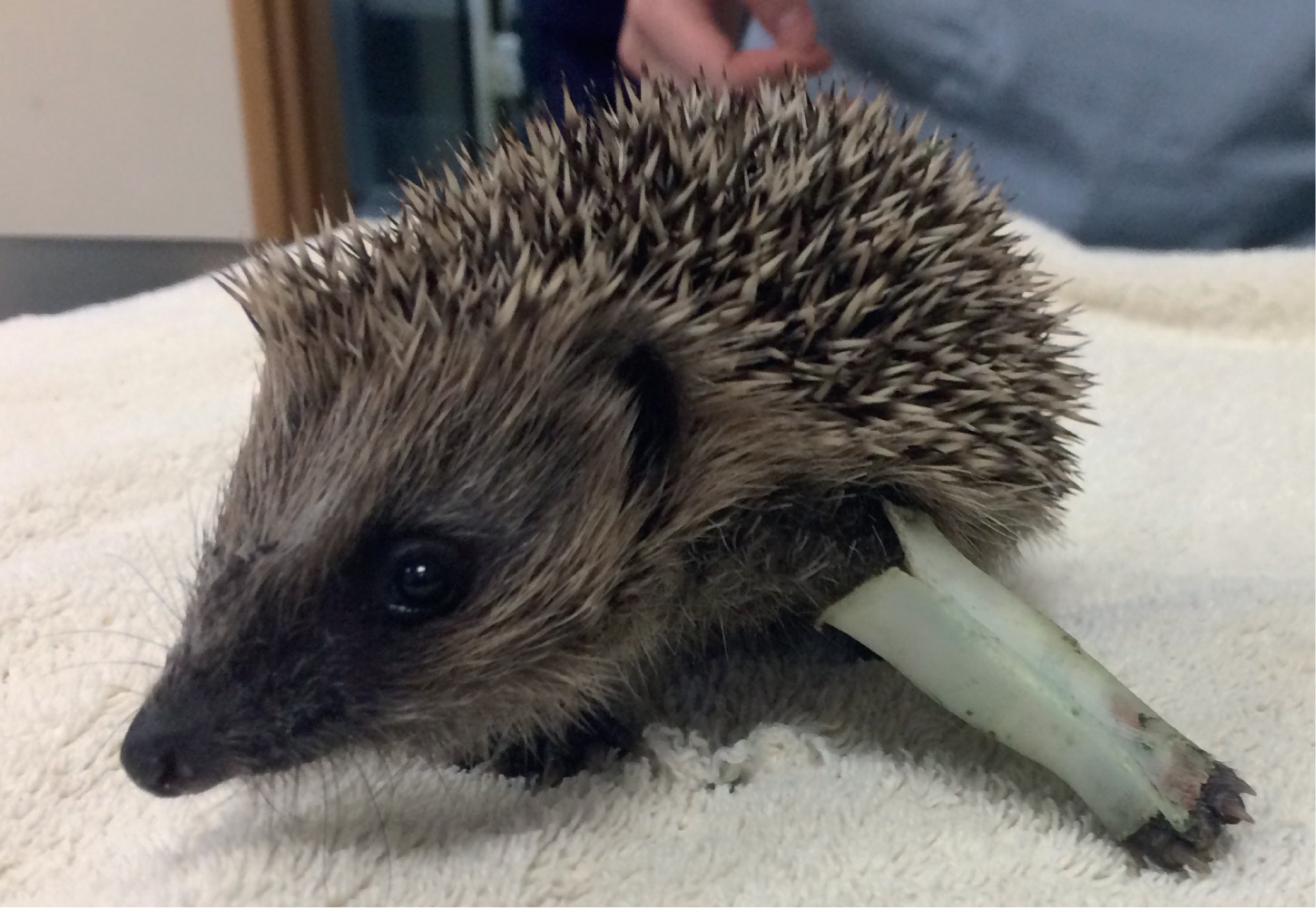
As veterinary professionals, it is important that we make ethical decisions about whether a wildlife patient will survive and thrive and must ensure that any chosen treatment does not prolong their suffering. Unfortunately, any wildlife patient that is injured and presents to a veterinary practice is already compromised, and if full recovery is not certain it may be more ethical to humanely euthanase the patient (Figure 3).
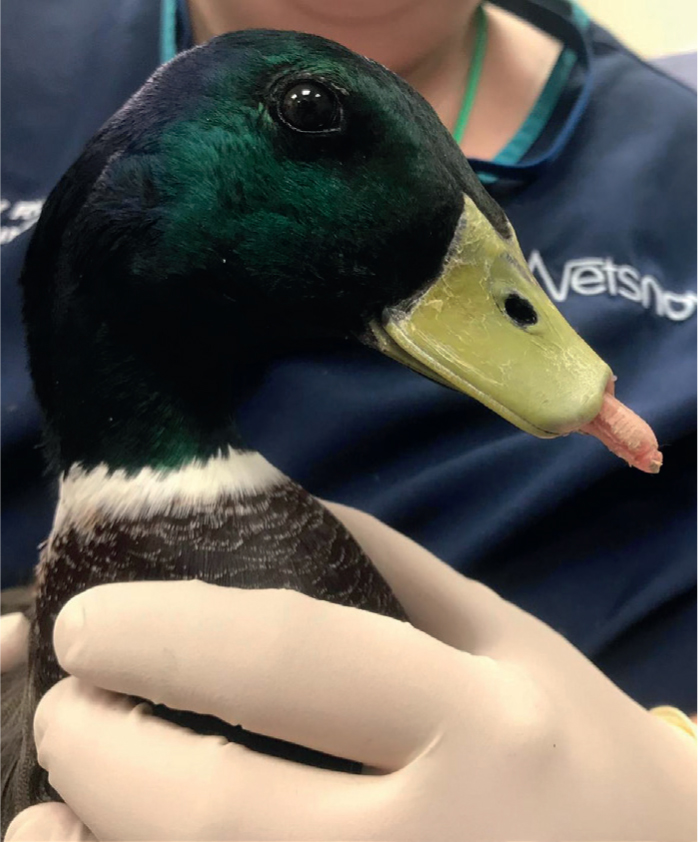
Schedule 3 of the Veterinary Surgeons Act (1966) allows for the administration of euthanasia drugs by veterinary nurses, under the direction of a veterinary surgeon. If performed correctly, euthanasia is not a welfare issue. The preferred method of euthanasia is an intravenous administration of pentobarbitone, ideally following sedation or general anaesthesia. If intravenous access is not possible, the patient should be first sedated or anaesthetised under the direction of a veterinary surgeon, and pentobarbitone should be administered by intracardiac, intraperitoneal, intrahepatic, intrarenal, or intracranial routes into the occipital sinus (Meredith, 2016). It is never appropriate to administer an injection of pentobarbitone outside of a vein, or to administer pentobarbitone orally or into the rectum or cloaca in a conscious animal.
Physical examination
If the patient has no obvious life-threatening injuries, a full physical examination should be performed once the patient has been allowed to calm in a dark, quiet environment (Figure 4). Sedation or anaesthesia administered under the direction of a veterinary surgeon may be required to facilitate this.
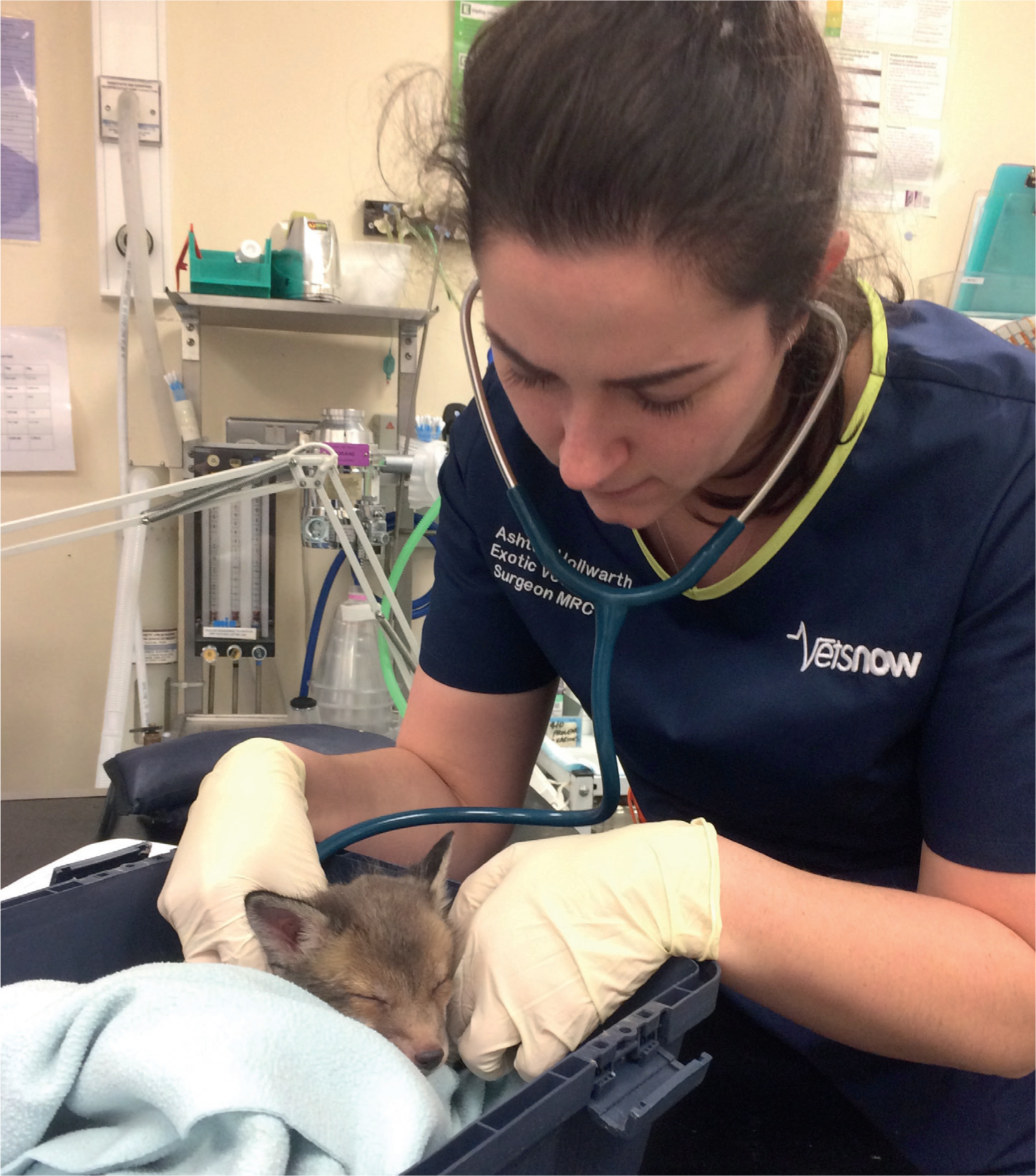
A thorough examination includes evaluation of the facial structures and mucous membranes, if safe to do so, to assess for hydration and cardiovascular stability (Figure 5). In birds with suspected trauma, an ophthalmic examination should be performed to assess the retina for detachment and the pecten oculi for signs of trauma (Graham and Heatley, 2007). The heart and lungs should be auscultated and the abdomen of mammals or coelomic cavity of birds, reptiles and amphibians palpated. The skin and musculoskeletal system should be assessed for any signs of wounds, bruising, fractures or luxations. A thorough palpation of all long bones and manipulation of all joints should be performed.
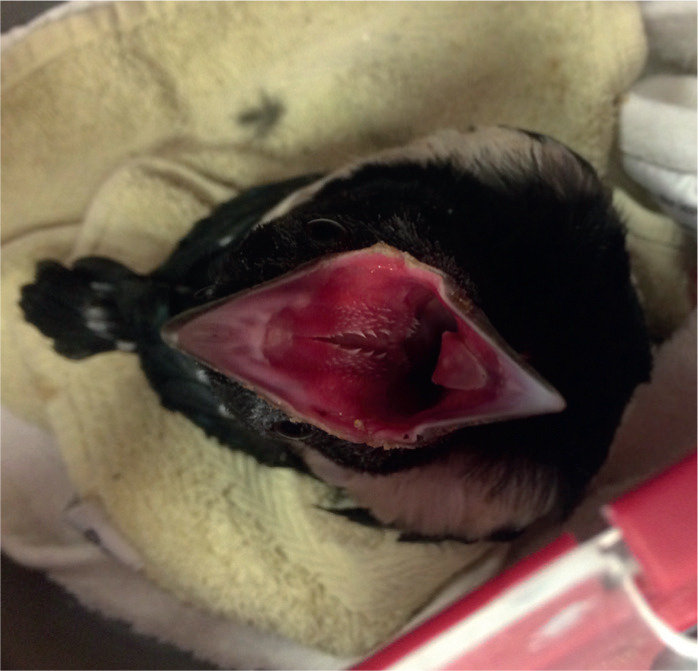
After a full physical examination, the answers to the questions in Table 1 should be re-assessed to see if any physical examination findings have changed the initial answers. If treatment is still feasible then it should be commenced without delay. Most presenting wildlife patients are dehydrated (Mullineaux and Keeble, 2016), and so fluids should be administered subcutaneously, intravenously or orally. If not previously provided, analgesia should be administered appropriately, under the direction of a veterinary surgeon.
Hospitalisation is stressful for most wildlife patients (Stocker, 2005) because of their survival instinct and their response to the unknown. A veterinary practice is an environment with lots of unknown sensory stimuli, such as hearing people, seeing other animals and people, handling and restraint, clinical smells and unusual food or water sources. Stress can impede recovery and have a direct effect on digestive metabolism, cardiovascular systems, and can create secondary conditions such as capture myopathy (Lloyd, 2017).
Patient hospitalisation and housing
It is important to have a collective awareness of what species can be safely and legally hospitalised, with consideration given to staff, patient and other patients' welfare and safety. Considerations include space, facilities, equipment and personal protective equipment (PPE) available as required (Figure 6). Examples of species-specific considerations are shown in Table 2. Some species are not safe to house in a veterinary practice depending on the individual practice equipment and facilities. Hospitalisation facilities should have suitable access for staff and patients with provisions for quick and efficient restraint being available.
Table 2. Risk and precautions for commonly presenting wildlife
| Species | Risks to be considered | Precautions recommended |
|---|---|---|
| Pigeons | Disease — chlamydia | Gloves and masks to be worn.Reduced contact with ‘at risk’ tasks |
| Badgers | Bite defenceDisease — tuberculosis | Gloves and masks to be worn, gowns if availableAnaesthesia for handling (use of injectable agents and crush cage for restraint) |
| Foxes | Bite defenceDisease — distemper, leptospirosis | Muzzles for handlingAnaesthesia for any procedure or restraint requiredGloves and aprons to be wornCare regarding other canine patients housed |
| Deer | KickingAntlersCapture myopathyDisease — tuberculosis | Large enclosures for housingHead covering to calm and keep darkGloves and masks to be wornSuitable staffing levels |
| Herons | Trauma to staff from beak injuries | Staff eye protection (shields/goggles) |
| Swans | BitesWing injuriesDisease — avian Influenza, chlamydia | Gloves, mask and aprons to be wornSwan hookLarge enclosure for housingSuitable staffing levels |
| Bats | Disease — lyssavirusBites | Double gloving (non-latex)Rabies vaccination of staffAnaesthesia for assessment/protection |
| Squirrel | Bite defenceDisease — leptospirosis | Anaesthesia for full assessmentGloves to be wornThick protection gloves for initial handling until anaesthetised |
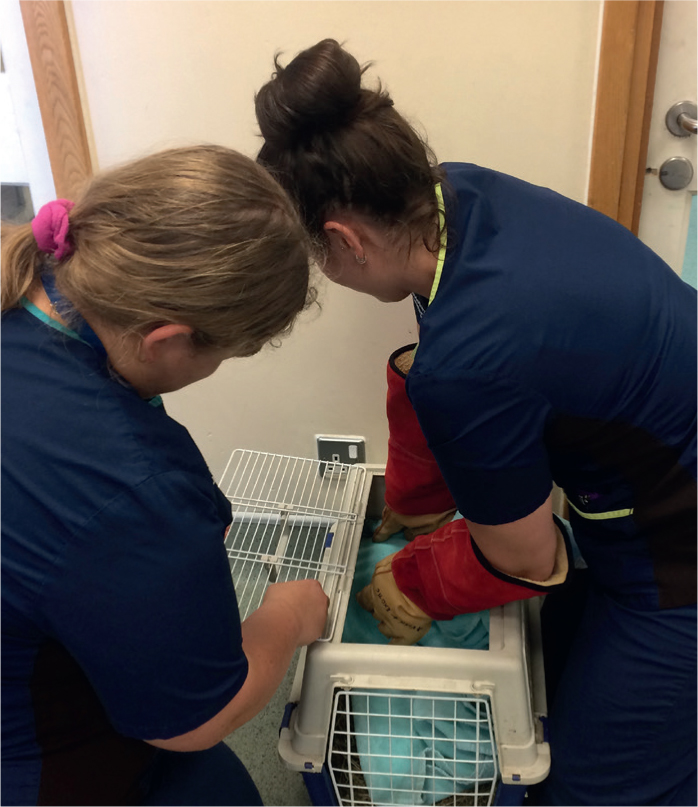
Housing wildlife in a quiet, darkened, low stimulating room can reduce a portion of stress as the stimuli individuals are exposed to (Figure 7). This can be achieved by use of a room which is otherwise empty (for example, a wildlife ward, or isolation ward), an empty clinical space such a consultation room, or a kennel in the quietest ward away from predators. Using newspaper to cover the metal kennel sides can reduce noise echo. Towels over the kennel door will protect avian feathers being damaged and will also help muffle sounds and darken the kennel so visual stimulus is reduced. Darkened environments simulate most patients' natural environment, such as dens, warrens, drays.
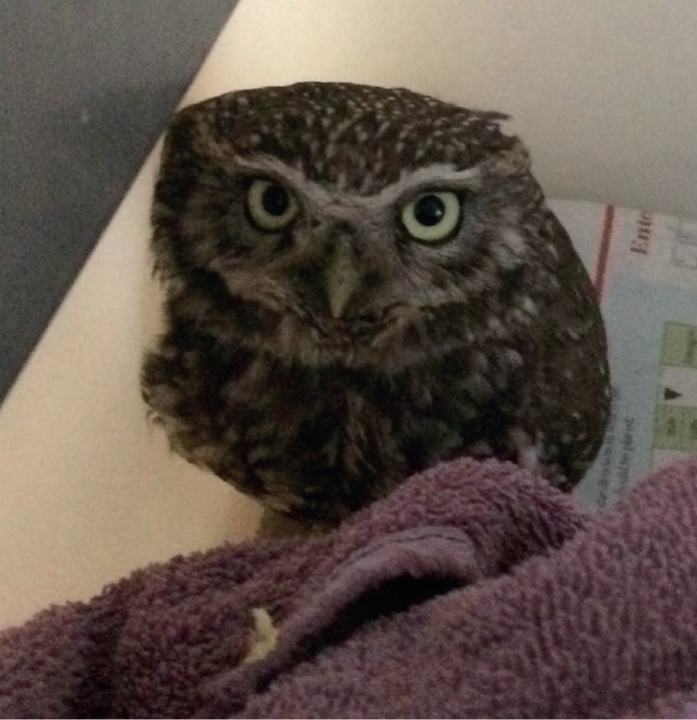
Kennels should be set up to account for the needs of the patients ensuring every individual has a space to hide away for ground dwelling species, and height provided for arboreal species. Food and water should be provided within the hide space, providing access in safety (British Veterinary Zoological Society, 2016). It is important to consider the normal level of habitat. Ground species should be housed in kennels on the lower levels, whereas arboreal species should be housed in higher kennels.
Kennel set up will vary depending on the species being housed. Waterfowl require deep padded bedding to reduce risks of pododermatitis (Figure 8). This can be achieved with use of orthopaedic mattresses or multi-layered padded bedding. Perching requirements will vary between hawks and falcons; hawks will require bow perching and falcons prefer block perching. This simulates what they would naturally perch on, for example, telegraph poles and tree branches. Nesting areas should be provided for small mammals such as rodents, hedgehogs and polecats. Bats and woodpeckers require a vertical surface to grip on to.
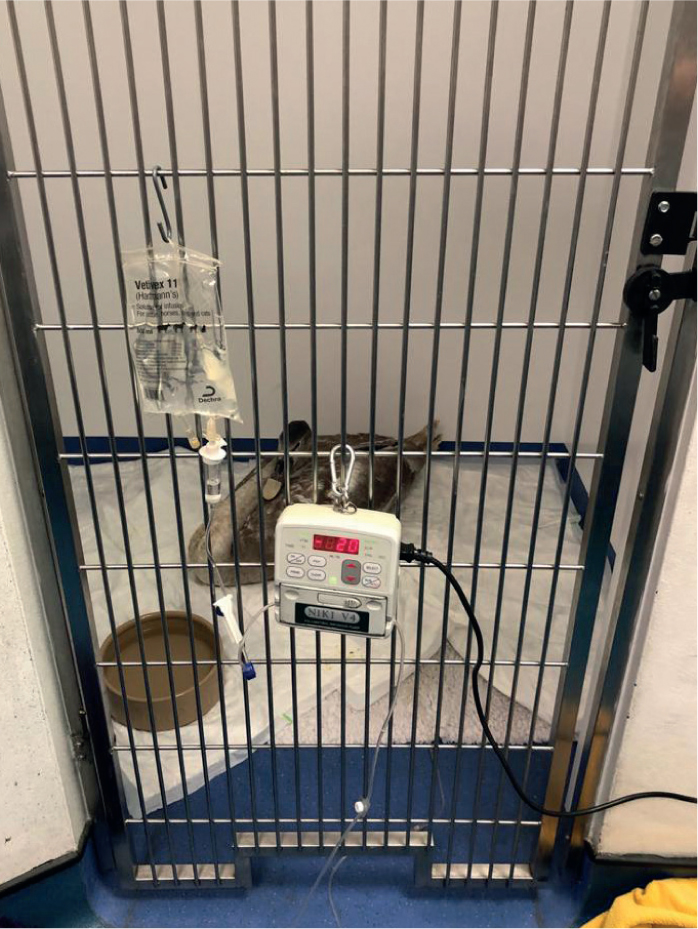
Any staff handling the wildlife must be competent and confident to allow minimal stress and injury (Haire, 2003). Any restraint or treatment of hospitalised patients should have a plan of action that should be collectively discussed with the team before any approach or handling of the patient, ensuring everyone is comfortable with their role. It is important to try and minimise handling to reduce the intensity of stress for the animal. This can be done by grouping medications together and ensuring swift, efficient care when medicating, examining or taking any samples.
It is important to consider what temperatures the individual is used to in the wild and to provide a warm environment for any sick animal without much of an extreme to their current climate temperatures (British Veterinary Zoological Society, 2016). This can help avoid shocking the system with severe temperature changes, which can alter a patient's metabolism and organ function. It is important to ensure that reptiles are provided with a suitable preferred optimum temperature range to allow them to maintain their own thermoregulation, metabolism and organ functions.
Diagnostics and sampling
Baseline diagnostics are important to help provide an initial assessment and understanding to the conditions which may be ongoing, and ill health. Common baseline tests are easily achievable using small animal methods for sample collection and interpretation, and could be used to aid guidance on treatment decisions and ethical recovery assessments (Cooper, 2003).
Blood sampling for total solids and packed cell volume can be used for assessment for anaemia, dehydration, protein levels and indications of infection. Running these tests would only require a small blood sample and can be obtained through standard blood sampling techniques, with venipuncture sites listed in Table 3. Assessment of the plasma colouration can also aid subjective assessments for signs of jaundice, lipaemia or haemolysis. It is important to consider sample technique to ensure accuracy of sample appearance. Assessment for a buffy coat on the spun haematocrit tube can be used for subjective white blood cell evaluation. If there is enough blood from the sample, a blood smear for white blood cell examination can be performed for objective assessment.
Table 3. Venipuncture sites of common terrestrial wildlife patients
| Mammals |
|
| Birds |
|
| Reptiles |
|
Faecal analysis for parasites can be of specific benefit to hedgehogs and birds of prey, as parasite burden of either primary or secondary conditions are common. Faecal floatation and direct assessment are carried out using the same methods as with small and large animal practice.
Survey radiographs can be beneficial for a triage assessment of extent of injuries (Figure 9). Radiographs should be performed under sedation or anaesthesia administered under the guidance of the veterinary surgeon. Further reading for guidance on positioning for radiographs can be found in Krutwald-Junghanns et al (2011).
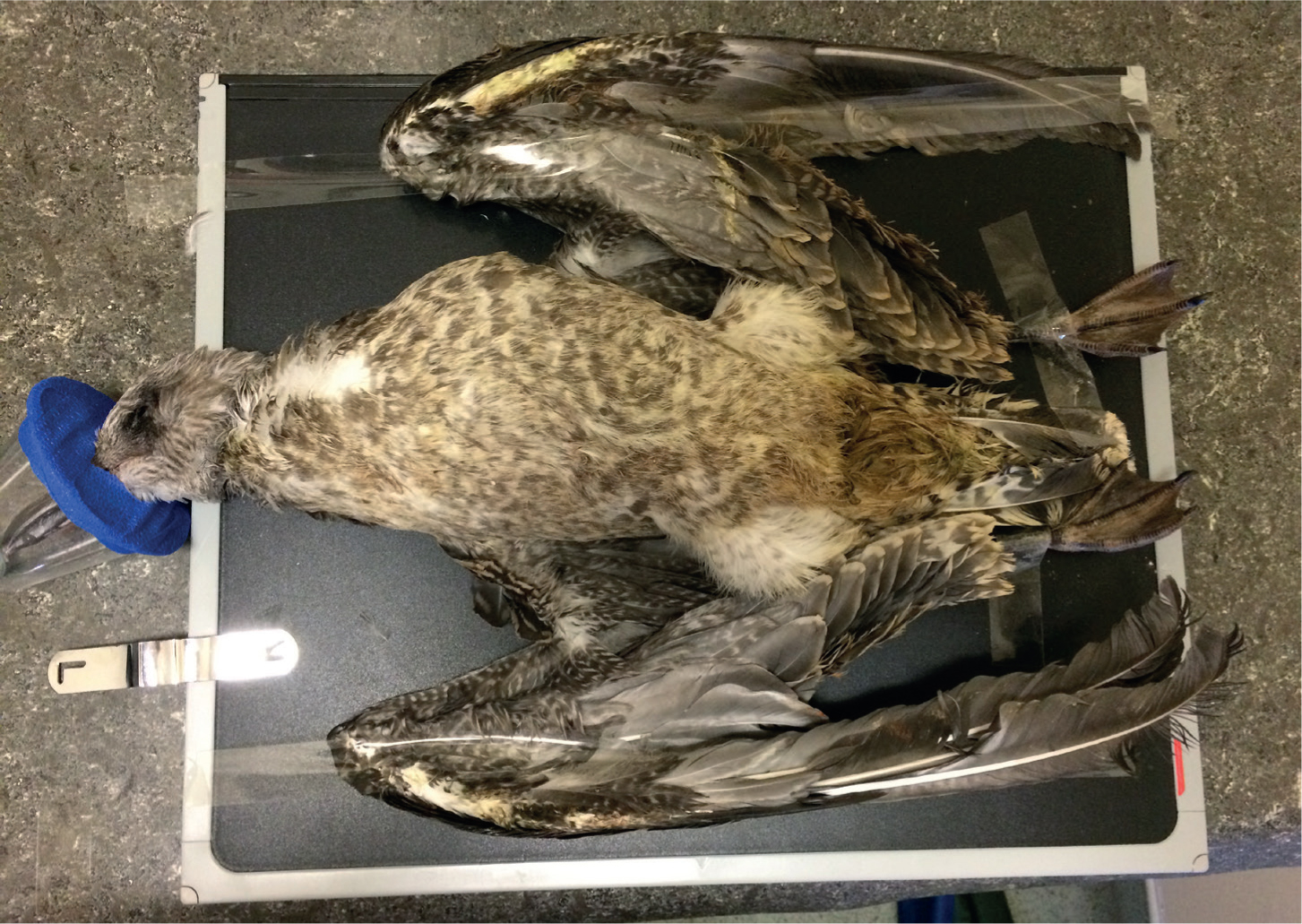
Medication, fluids and nutritional support
Treatment should include a combination of medication (as relevant to individual), fluid therapy and nutritional support. Most wildlife patients are unlikely to voluntarily eat and drink and supportive hydration and nutrition are often required. Supported feeding for mammals should be provided through syringe feeding the appropriate diet to the species. For smaller mammals such as rodents and hedgehogs, small pipette tips on the end of the syringe can be beneficial. Avian patients can be gavage fed directly into the crop. This involves placement of a tube (soft tube for waterfowl, birds of prey and game birds, metal feeding tubes for other species) into the crop via the oral cavity (Figure 10). Supportive nutrition in reptiles and amphibians can be provided by syringe feeding a semi-elemental diet as similar as possible to their natural nutritional requirements. When opening reptile mouths, there is risk of injury to the patient and therefore using a piece of card or tongue depressor can be useful to open the jaw and protect the dentition and jaw structure.
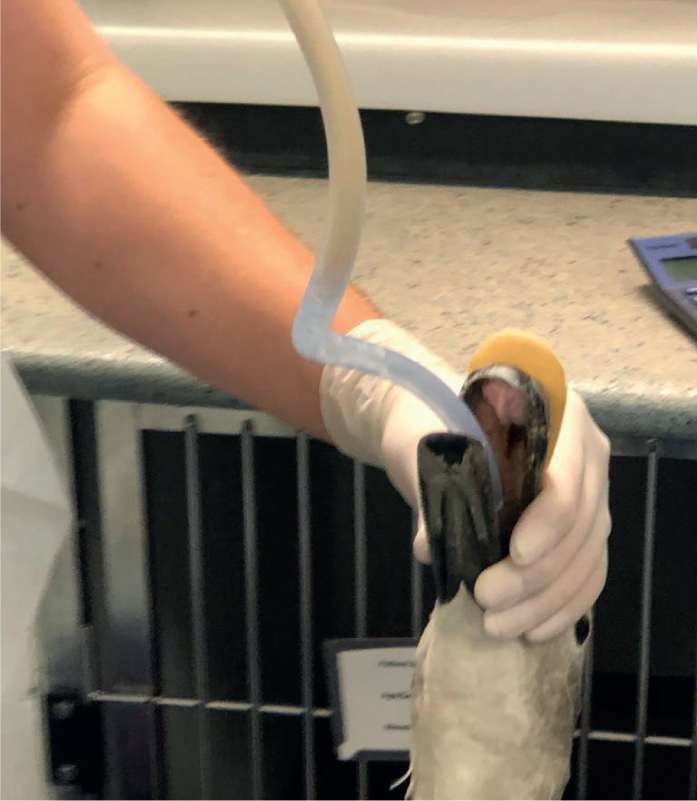
The diet offered should be as close to their normal wild feeding opportunities as possible, and opportunities for supportive feeding should be available if the patient becomes anorexic or hyporexic. It is important for patients to recognise food being offered. Captive species and wild species will likely recognise different presentations of food. In carnivores, sourcing specific food may be required, such as skinned prey, ideally pre-warmed to simulate fresh prey. Care should be taken with raw meat, and suitable risk assessments and protocols should be adhered to for staff and patient safety. Wild herbivores would commonly be feeding on fresh grasses and vegetation so in captivity farmed foods or hay would not be what they are used to. Waterfowl need their food in a water source, such as a deep litter tray of water, allowing whole head submergence to allowing beaks to filter food from the water (Haire, 2003). This water requires frequent changing because of patient fouling and risk of increased bacteria growth if left for extended periods of time. A second water source in a similar format would be recommended for drinking. In times of uncertainty as to how best to house a species, local wildlife rescues, charities or animal collections may be able to provide good advice until they are stable enough to be transported to a wildlife rehabilitation centre.
Injectable medications are initially preferred in wildlife as a minimal stress method and ensure full administration compliance. The goal is to transition to oral medication once the patient is stable. Areas for subcutaneous and intramuscular injections (Figures 11 and 12) are outlined in Table 4.
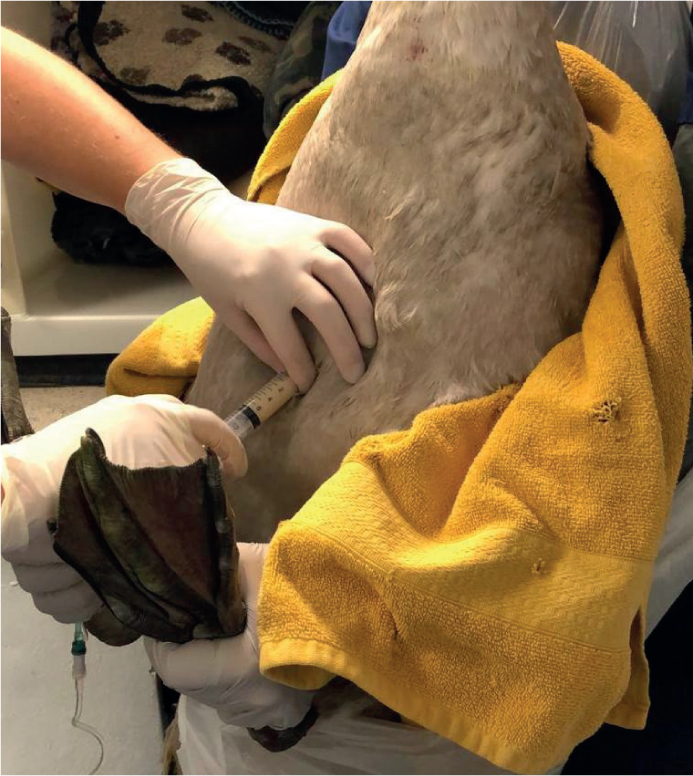
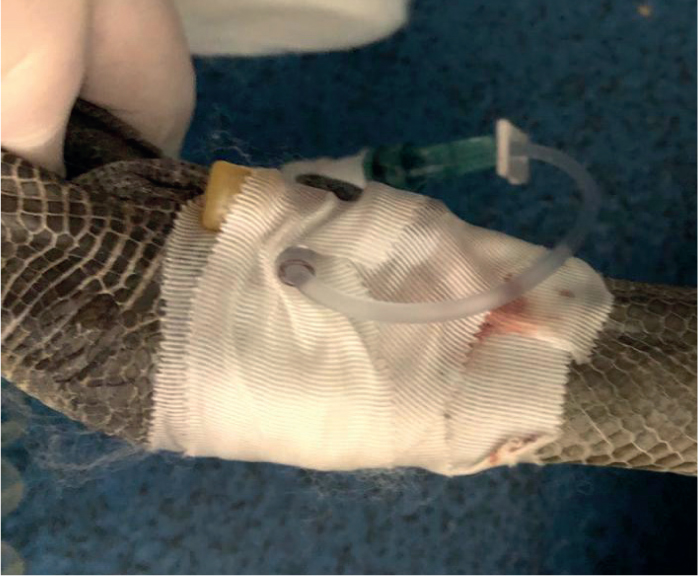
Table 4. Injection sites of common terrestrial wildlife patients
| Subcutaneous | Intramuscular | |
|---|---|---|
| Mammals |
|
|
| Birds |
|
|
| Reptiles |
|
|
Patient discharge and release
Patients being discharged from hospital should either be released to the wild if fit for release or discharged into the care of a reputable wildlife rescue centre for rehabilitation. The goal is for patients to leave a veterinary clinic as soon as is feasible. Those that cannot be released until a course of treatment is completed should be discharged to a wildlife rehabilitator as soon as possible. When identifying a reputable wildlife rescue, the authors recommend looking for a registered charity, ideally with facilities to treat patients requiring medication and with appropriate soft release facilities. Full guidance on good practice guidelines for wildlife rehabilitation centres has been extensively provided by the British Veterinary Zoological Society (2016). Veterinary practices should endeavour to build up a strong relationship with local wildlife rescues centres in order to ensure that the welfare needs of any patients being transferred will be met.
The goal of treating wildlife patients should always be their eventual release. A wildlife patient should be kept in captivity for as short a duration as possible, reducing their potential exposure to infectious diseases (Tomlinson, 2016). Soft release should ideally be performed when releasing wildlife patients that have been juvenile or orphaned, or those that have spent an extended period of time in rehabilitation. This involves placing the animal into a suitable enclosure in a sheltered area that mimics the environment for its eventual release (Grogan and Kelly, 2016). This method of release allows the patient to be monitored for any difficulties it may encounter accessing food or manoeuvring within the environment, and allows acclimatisation. This can be a time-consuming process, and the initial set up can be expensive, so it is recommended that this be performed by an experienced wildlife rehabilitation centre (Grogan and Kelly, 2016). There are a few reasons that a wildlife patient may need to be kept in captivity longer than their treatment course, for example migratory birds such as the Eurasian Hobby (Falco subbuteo) or Common Swift (Apus apus), or if a patient would normally hibernate during its treatment course, such as a European Hedgehog (Erinaceus europaeus).
Wildlife patients should always be assessed to be fit to release before releasing them back to the wild. While this assessment is usually carried out by wildlife rehabilitation centres, it may fall to veterinary staff to perform this when the patient is under the care of a veterinary practice. The Abandonment of Animals Act (1960) rules that it is an offence to release a wild animal that is currently suffering or is not fit for survival and where being released to the wild will result in suffering. This is also important to consider when the patient first arrives, as it is important not only to assess its initial injuries, but also its prognosis for returning to the wild.
Conclusion
Treatment of wildlife patients can be rewarding and fulfilling, especially when veterinary practices establish a close relationship with their local wildlife rescue. It is important to understand the limitations associated with treatment when patients being released must be fit to survive and thrive, and it is the responsibility of the veterinary and rehabilitation teams to ensure these criteria are met before releasing the patient. However, wildlife patients can be treated effectively and with minimal stress, with veterinary teams contributing significantly to the welfare of our national wildlife.
KEY POINTS
- Initial triage of wildlife patients occurs from the point of first contact, even before the patient presents at the veterinary clinic.
- The Royal College of Veterinary Surgeons does not require practices to have members of the public ‘sign over’ wildlife patients, as they are by their very nature not owned, but practices may still wish to do so to avoid any doubt as to who is responsible for the patient.
- Criteria for euthanasia depends not just on the injuries sustained by the wildlife patient, but also their temperament for hospitalisation, length of treatment required, skills of the veterinary practice and local wildlife rescues and the species of the patient.
- Housing of wildlife in veterinary practice should be as stress-reducing as possible to provide improved welfare and optimum recovery conditions until they can be released.
- Good relationships with the local wildlife centres and animal collections, allow improved knowledge base sources and can provide a good knowledge bank as required.


